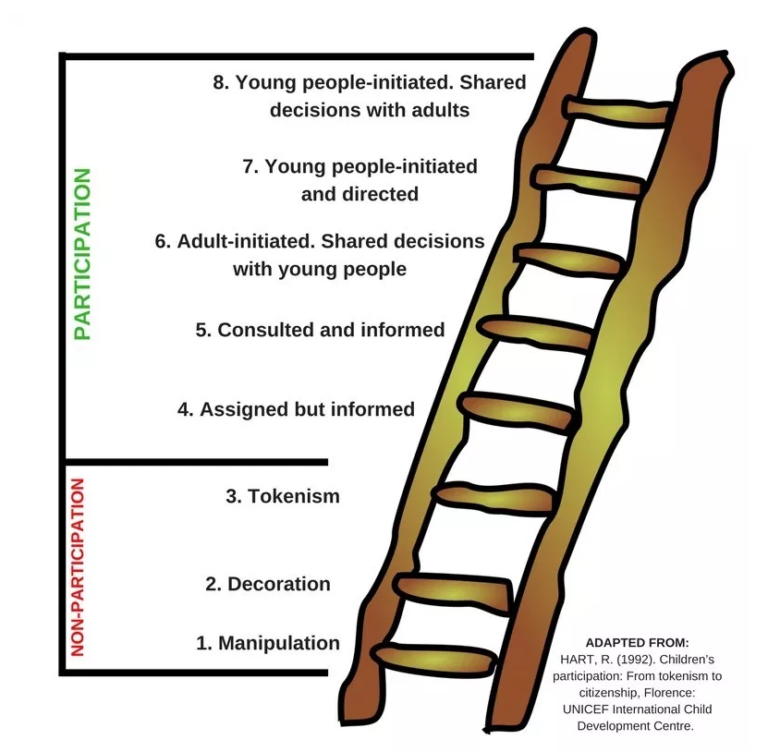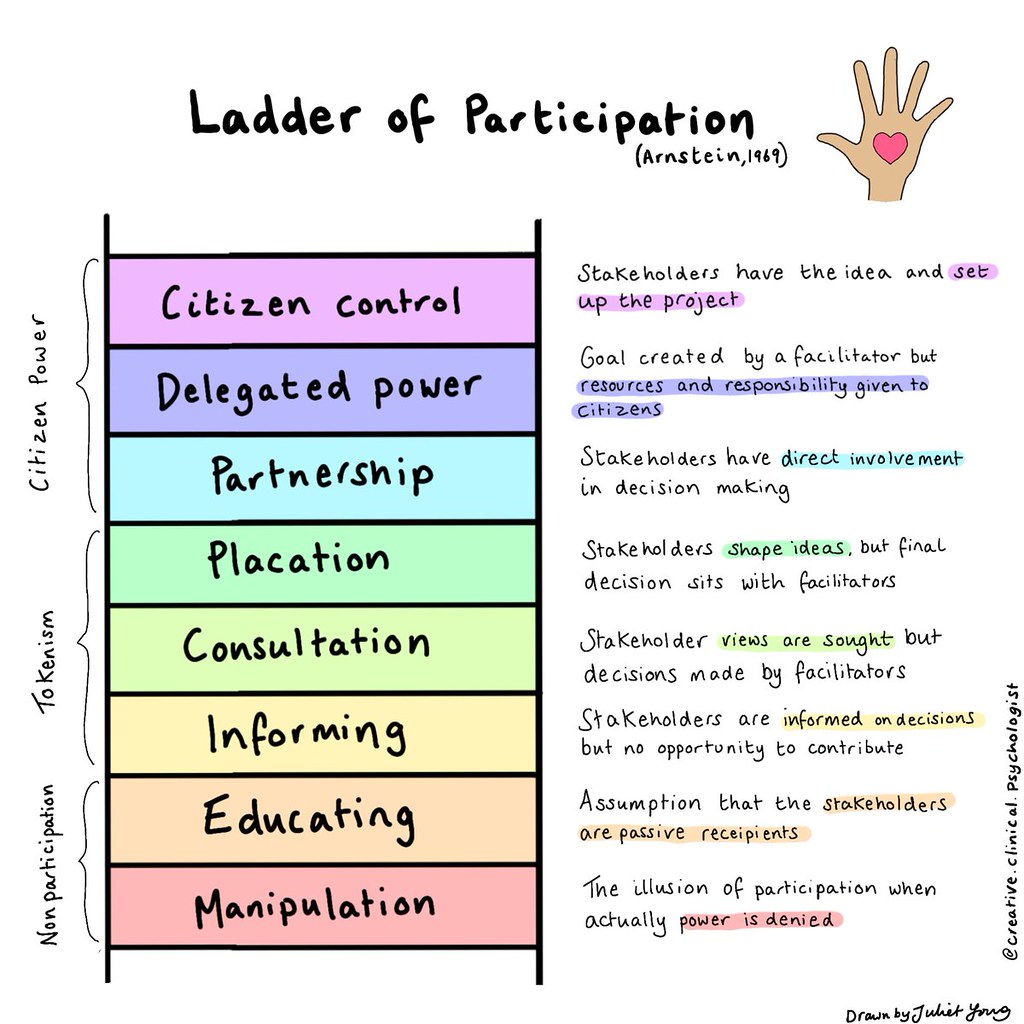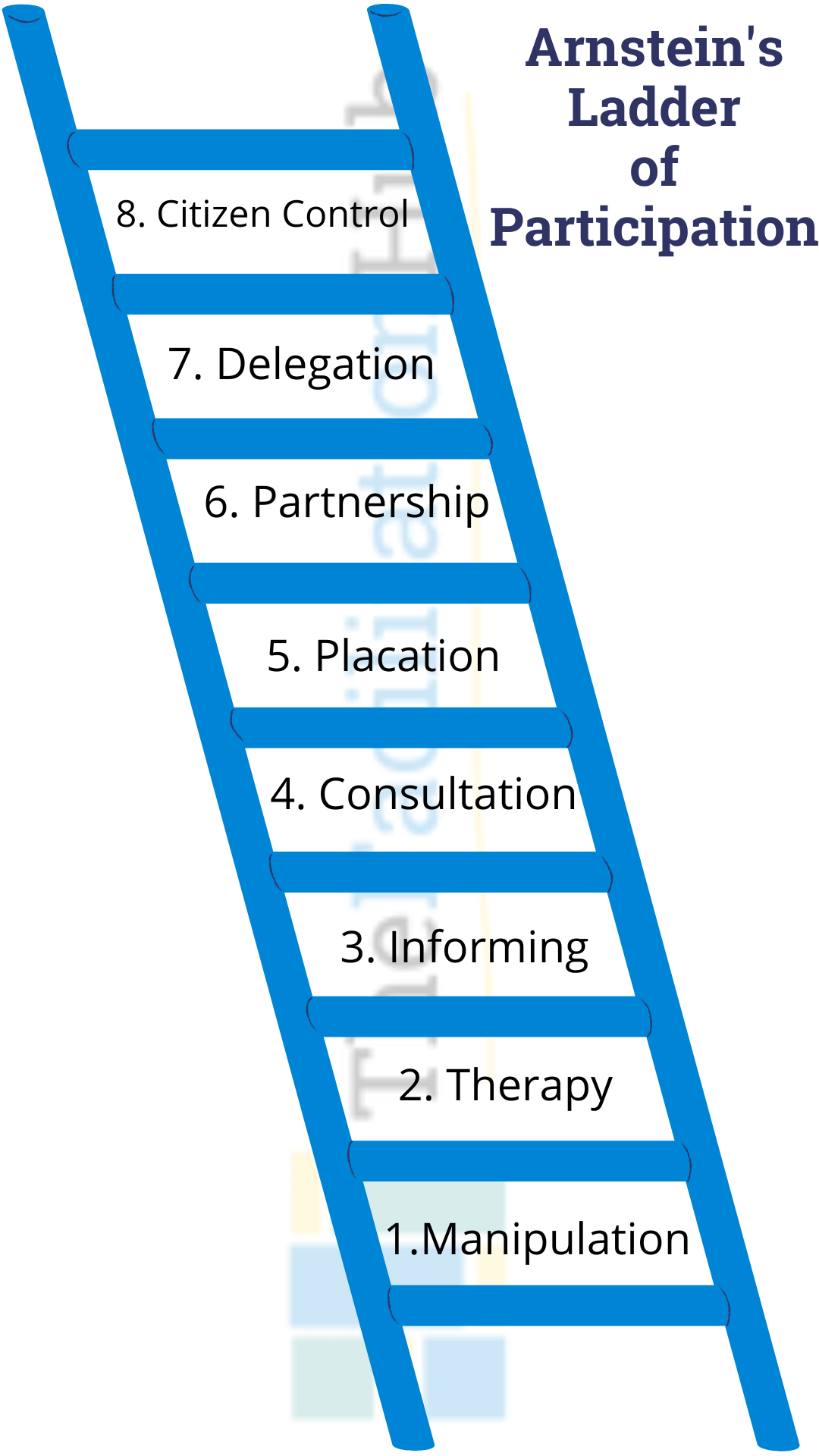
ARNSTEINS LADDER OF CITIZEN PARTICIPATION ENVIRONMEN 4772
Abstract. Problem, research strategy, and findings: Arnstein's (Citation 1969) ladder of citizen participation has been prominent and influential in the planning field.By detailing a continuum of approaches for citizen involvement, the ladder provides a foundation for addressing questions of participation and power in theory and practice.

Models of participation. Three models of participation (Arnstein, 1969;... Download Scientific
The ladder of citizen participation. Scientific research around participation works primarily with typologies. Particularly in the 1990s, a number of schemes were developed. The foundation for the history of typologies was laid as early as 1969 by Sherry Arnstein, whose 'Ladder of Citizen Participation' is still frequently used today.

Arnstein's (1969) 'ladder of participation'. Download Scientific Diagram
To address this issue, we introduce a process-oriented framework based on theory that should help to advance best practices and scholarship in CETL: Arnstein's (1969) Ladder of Citizen Participation. We then "test" this framework adapted for CETL by using it to assess examples of community participation in CETL, as evidenced in a.

A ladder of participation by Sherry Arnstein (1969). Figure 2 A ladder... Download Scientific
Sherry R. Arnstein. Pages 216-224. To encourage a more enlightened dialogue, a typology of citizen participation is offered using examples from three federal social programs: urban renewal, anti-poverty, and Model Cities. The typology, which is designed to be provocative, is arranged in a ladder pattern with each rung corresponding to the.

Roger Hart’s Ladder of Children’s Participation
Classifying participation Ladder of citizen participation, Sherry Arnstein. Sherry Arnstein discusses eight types of participation in A Ladder of Citizen Participation (1969). Often termed as "Arnstein's ladder of citizen participation ", these are broadly categorized as: Citizen Power: Citizen Control, Delegated Power, Partnership.

1 Arnstein's ladder of citizen participation Download Scientific Diagram
Proposed by Sherry Arnstein in 1969, the Ladder of Citizen Participation is one of the most widely referenced and influential models in the field of democratic public participation. For local leaders, organizers, and facilitators who want to understand foundational theories of public engagement and participation, and the ways in which empowered.

The ladder of citizen participation (Arnstein, 1969) Download Scientific Diagram
By Gabriele Bammer What can researchers interested in stakeholder engagement learn from two classic frameworks on citizen involvement in government decision making - Arnstein's ladder and the IAP2 (International Association for Public Participation) spectrum of public participation? Arnstein's ladder Sherry Arnstein (1969) developed an eight-rung ladder, shown in the figure below, to.

Ladder of Participation (Arnstein, 1969) a photo on Flickriver
The eight rungs of the Ladder of Citizen Participation are: 1. Manipulation. An "illusory" form of participation, manipulation occurs when public institutions, officials, or administrators mislead citizens into believing they are being given power in a process that has been intentionally manufactured to deny them power. In Arnstein's words: "In the name of citizen participation, people.

Arnstein’s Ladder of Participation Is it Still Relevant?
Arnstein's Ladder of Citizen Participation. Source: "A Ladder of Citizen Participation," by S. Arnstein, 1969, Journal of the American Institute of Planners, 35(4), p. 217. # 1969.

Arnstein`s ladder of participation in public organizations Download Scientific Diagram
Arnstein's Ladder of Citizen Participation (Arnstein, 1969, p. 217) An Illustration of my Coding Approach in my Literature Review Burns et al.'s Participation Scale (Burns et al., 2004: 60)

Arnstein’s “ladder of citizen participation” in planning shows... Download Scientific Diagram
Two well-known efforts are Sherry Arnstein's 1969 ladder of citizen participation and Sarah White's 1996 work on the forms and functions of participation. The ladder of citizen participation From bottom to top, the steps explain the extent of citizen participation and how much real power citizens have to determine the process and outcomes.
Eight rungs on the ladder of citizen participation (Arnstein, 1969). Download Scientific Diagram
Abstract. Problem, research strategy, and findings: Sherry Arnstein's "A Ladder of Citizen Participation" is the cornerstone for planners thinking about citizen participation. Arnstein wrote the article based on her experiences working at the Department of Housing and Urban Development (HUD) from 1967 to 1968 as the chief advisor on citizen participation in the Model Cities Program.

Arnstein's ladder of citizen participation (Arnstein, 1969, 217). Download Scientific Diagram
Sherry Arnstein (1930-1997), a government official charged with citizen participation in the US federal Model Cities Program in the late 1960s and early 1970s uses the metaphor of a ladder to describe levels of citizens' participation in urban programs and development decisions that affect their lives in this classic 1968 article from the Journal of the American Institute of Planners.
Eight steps on A Ladder of Citizen Participation. Source (Arnstein, 1969) Download Scientific
Sherry Arnstein, writing in 1969 about citizen involvement in planning processes in the United States, described a "ladder of citizen participation" that showed participation ranging from high to low. See Sherry R. Arnstein's "A Ladder of Citizen Participation," Journal of the American Planning Association, Vol. 35, No. 4, July 1969.

Arnstein's Ladder of Citizen Participation. Source "A Ladder of... Download Scientific Diagram
However relevant these (older) models are in showing the alignment of the critical with participation, and the importance of power for participatory analyses, these ladder-based models also have a series of problems (most of which are acknowledged by Arnstein [Citation 1969, 217]). Quite often, these models suggest the existence of easy cut-off.

Hart's reconfiguration of Arnstein's ladder of participation. Download Scientific Diagram
A typology of eight levels of participation may help in analysis of this confused issue. For illustrative pur poses the eight types are arranged in a ladder pattern with each rung corresponding to the extent of citizens' power in determining the end product.s (See Figure 2.) The bottom rungs of the ladder are (1) Manipula tion and (2) Therapy.